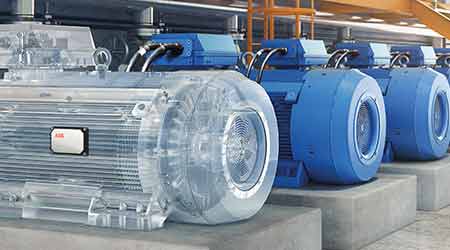 ABB
ABBEnergy-Efficient Motors Declared Mandatory Since 1997
Part one of a three-part article on motors and drives
A motor has failed, or technician testing has indicated it is deteriorating and needs to be replaced. Managers in this situation face two options. They can decide to have technicians repair the existing motor, or they can specify a new motor to replace it. In general, repairing it offers lower first costs while replacing it offers the opportunity to improve the application’s energy efficiency.
Most motors manufactured before 1992 are considered standard-efficiency motors. Since then, higher operating efficiencies have become mandatory, first in 1997 and again in 2010. Managers can recover the additional cost of higher-efficiency motors fairly quickly through energy savings, particularly if the motor is in continuous use. The U.S. Department of Energy and most motor manufacturers offer software managers can use to evaluate the savings produced by installing higher-efficiency motors for a range of applications and annual run times.
While energy efficiency is an important factor to consider when evaluating the repair-or-replace question, it is not the only one. Managers need to take into account additional factors that depend to a great extent on the application and vary among facilities.
The first step is to consider the application. Is the failed motor the correct motor for that application? Was it oversized or undersized? Has it been damaged in the past? What failed in the motor? Technicians can correct simple failures with such actions as bearing replacement or shaft straightening, which are relatively inexpensive. More extensive repairs, such as rewinding or replacing the rotor bars, are significantly more expensive and require careful evaluation.
In general, if the motor is a standard motor, meaning it is available off the shelf, and if it is less than 25 hp, the rule of thumb says it is more economical to repair failed bearings but not to perform a rewind on the motor. Bearing costs are low when compared to the cost of replacing a motor, but the cost of rewinding is not low.
If the motor is a standard motor and greater than 25 hp, the same rule of thumb applies to bearing replacement, though not to rewinding. For these motors, managers should get a quote for the cost of the rewind. The rule of thumb is if that rewind cost is 50 percent or less than the cost of a new, premium-efficiency motor, the rewind is the better option. Managers need to remember, though, that rewinding a motor results in a slight decrease in its operating efficiency.
Rules of thumb aside, downtime frequently drives the decision to replace rather than repair. In many cases, replacement motors are readily available, and technicians can install them in as little as a day. In other cases, the replacement motor might not be a standard motor and might require a fairly long lead time to order. The time required to repair a failed motor varies with the size of the motor and the workload in the repair shop. Managers must consider the length of time the application can be down before deciding on the most appropriate option for the facility.
Managers need to check with the local utility to see if rebates are available for improving the operating efficiency of motors in a given application. Combined with the improvement in energy efficiency, the rebate might be enough to tip the balance in favor of replacement.
Managers also need to consider the warranties offered for a motor repair compared with replacement. Warranties have value and are part of the evaluation process.
James Piper, P.E., is a national facilities consultant based in Bowie, Md. He has more than 30 years of experience with facilities maintenance and engineering issues.
Related Topics:















